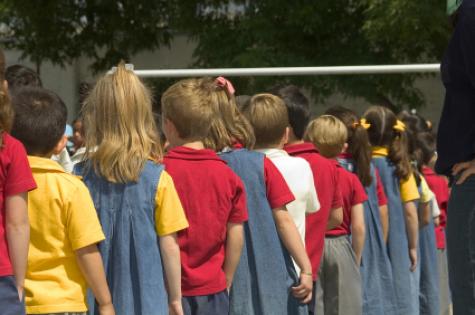The ‘Gonski’ reforms are a good thing.
In a nutshell, what ‘Gonski’ (named after the University of New South Wales Chancellor who chaired the committee) means is that every Australian child will receive the level of government funding necessary to meet a required education standard over a sustained period, so that every child has the best school education possible as the stepping stone to a better life.
The policy imperative behind the report is the growing gap in student outcomes between those from low socio-economic backgrounds and those who are better off. This is despite significant measures by previous governments designed to improve the rate of school completion and increase the number of kids going on to further education.
In 1974, the Whitlam Government introduced virtually free university education from which an entire generation of late baby boomers and Gen X benefited until the Hawke Government introduced the Higher Education Contribution Scheme (HECS) in 1989. HECS became necessary because of another measure of the Hawke Government very early in its first term in 1983 which saw the school completion rate – that is, the number of children completing Year 12 – increase from around 37% of Year 10 students to around 70% in a relatively rapid timeframe. This put enormous pressure on the university system as more and more students finished school and wanted to go on to further study; and the way in which government could afford to fund more university places was to introduce a relatively modest contribution from the student by way of HECS.
However, more than 25-35 years later, there is still a gap in performance, completion and access to higher education. Students from high socio-economic backgrounds are still much more likely to finish school and will go on to university at double the rate of those from low socio-economic backgrounds.
So, if we accept as parents and as a society that the most important investment we can make in our children and our nation is education, there is surely no-one in the country who disagrees with what lies at the heart of the Gonski reforms.
The ‘noise’ since the pre-announcement in the traditional Sunday press, and the argy-bargy we will see at the Council of Australian Governments meeting on Friday, is mostly all about who pays for it.
Prime Minister’s proposal
The Gillard Government is proposing a $14.5 billion increase to schools funding over six years subject to the State and Territory governments contributing 35% of the amount, taking total government spending on schools to $49.5 billion on average per year up to 2019. This is approximately a $2.4 billion a year increase, less than half of what Gonski recommended was required to bring the school system up to the desired level of performance.
The Federal Government also announced it would fund its share of the increase by savings over four years:
- an ‘efficiency dividend’ of 2% in 2014 and 1.25% in 2015 to universities contributing approximately $900 million
- removing the 10% discount on paying HECS contributions upfront and the 5% bonus for voluntary repayment of debts contributing approximately $230 million
- conversion of scholarships for university students from low socio-economic backgrounds into loans to be repaid once a certain income threshold is reached, saving $1.2 billion, and
- limiting tax deductibility of self-education expenses to $2,000pa per person from 1 July 2014, with a saving of $520 million.
In the four-year period of the ‘forward estimates’ – the timeframe in which government considers the Budget outlook – the gap between the promised new expenditure and the announced savings is $3.6 billion. It is unclear where the remainder of the savings is coming from.
Savings to higher education
Most of the savings measures so far announced by the Government are reasonable, especially in the context of what is driving the Gonski reforms – equity and access.
The significant majority of those who pay the HECS contributions upfront are from high socio-economic backgrounds who can afford to pay. Those who pay to make the most of the 10% discount still have the option of the delayed payment; those who pay as a ‘gift’ to their children will not be deterred by having to pay 10% more. Conversion of scholarships into loans for people from low socio-economic backgrounds should not deter students from those backgrounds who want to go on to university: like HECS, it is only repayable once an income threshold is met.
The biggest impact on the university sector will come by way of the efficiency dividend – the favourite saving of the Department of Finance when they can’t think of another reason for a saving. Public service departments have been living with efficiency dividends for yonks. The universities that will be hit the most are the mid-range and regional universities.
The peak body representing Australia’s 40 universities has said the cuts will place a “severe strain” on the sector especially as it has been encouraged to offer more places. They have not called for the savings measures to be overturned but instead have pushed for other reforms they have been lobbying the Government about for some time – most notably a Productivity Commission review of the regulatory and reporting burden on universities.
The Opposition claims that “if Labor had been competent in managing and growing the Australian economy” then these cuts wouldn’t be necessary. Opposition spokesperson, Christopher Pyne refers to the announcement as a “Conski” claiming the Gillard Government has cut $11 billion in education expenditure in recent times.
The Greens believe that if the Government increased the mining tax these cuts wouldn’t be necessary, but supports the Gonski reforms.
The Independent MP, Andrew Wilkie, has already drawn a line in the sand and said he’ll not support the cuts because it’s “robbing Peter to pay Paul”.
State governments
The first issue some State governments will argue over on Friday is around the variable new funding. The Prime Minister outlined that NSW will receive $5 billion extra under the changes, while other states - notably South Australia and Western Australia - less.
The reason for this is that the Gonski report also recommended that schools in greatest need should receive a supplement, and a further adjustment should be made to school communities where parents have the capacity to pay fees.
On the one hand, the different rates are justified on the basis that, for example, NSW has a high proportion of students from disadvantaged backgrounds. On the other hand, States such as South Australia and Western Australia will argue that they are being made to pay for an under-investment in other States over a number of years. Nonetheless, overall the additional funding is roughly fair on a proportional basis. For example, NSW is receiving 29% of total funding, Victoria 23%, Queensland 22%, Western Australia 13%, South Australia 7% and Tasmania, the ACT and NT 2% each.
However, the larger issue for the State and Territory governments is the extent to which they can sustain the political and financial argument about their capacity to fund the increase in funding required from them.
The States and Territories are being asked to meet 35% of the Gonski funding increase, as well as agree to new indexation arrangements which would see the Feds increase schools funding by 4.7% each year if the States contribute 3% growth.
The Prime Minister presents this as a fair and reasonable co-contribution. State Treasuries will be concerned that it doesn’t take account of what is already a growing imbalance in government budgets, with a deteriorating outlook for Budget revenues, and the increasing financial demands on both Federal and State budgets because of the big reforms of the Federal Government.
Show me the money
Measures such as the NDIS, vastly enhanced early childhood education, aged care, the NBN, infrastructure projects such as new roads and a new Sydney Airport all cost huge, huge amounts of money. They are almost without exception significant nation-building projects that are needed – but at what cost?
The $730 million saved by stripping some single parents of their benefit? An ‘efficiency dividend’ that will hurt mid-range and regional universities more than most?
Perhaps the best and only solution to financing the big reforms the nation needs and wants, without further erosion of the overall financial position, is to reform the tax system including the GST. How else are we going to continue to fund long term, significant and ongoing commitments built on a fluctuating and deteriorating financial base?
Tax systems continuously face new pressures and need updating. Other than the mining-tax-when-you-don’t-have-a-mining-tax, the Government lacked leadership when it needed it most by welching on the ‘Henry reforms’ of four years ago.
But if we want to build a nation that’s capable of meeting the range of important public policy objectives to meet the community’s expectations on living standards and to ensure our children’s children have the best chance in life, something’s gotta give.
The issues we face are not something that can be fixed on the morning of 15th September – the day after the election – but ones which will be as relevant to the next government as they are to this one.



















__small.png)










